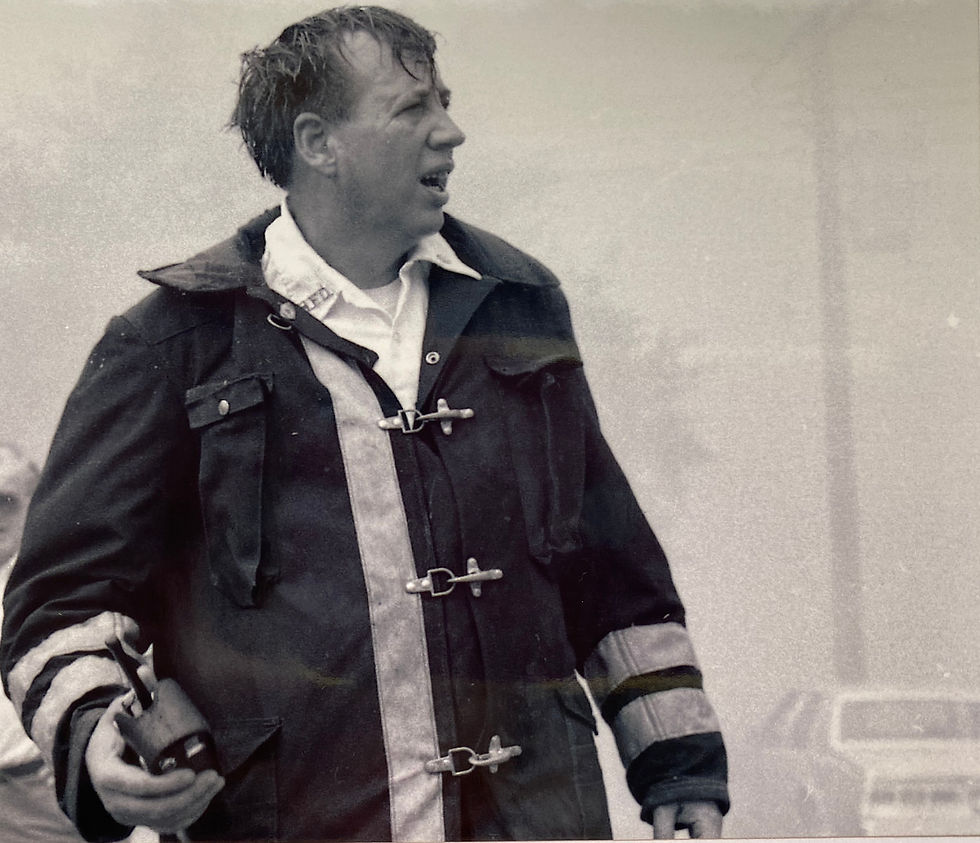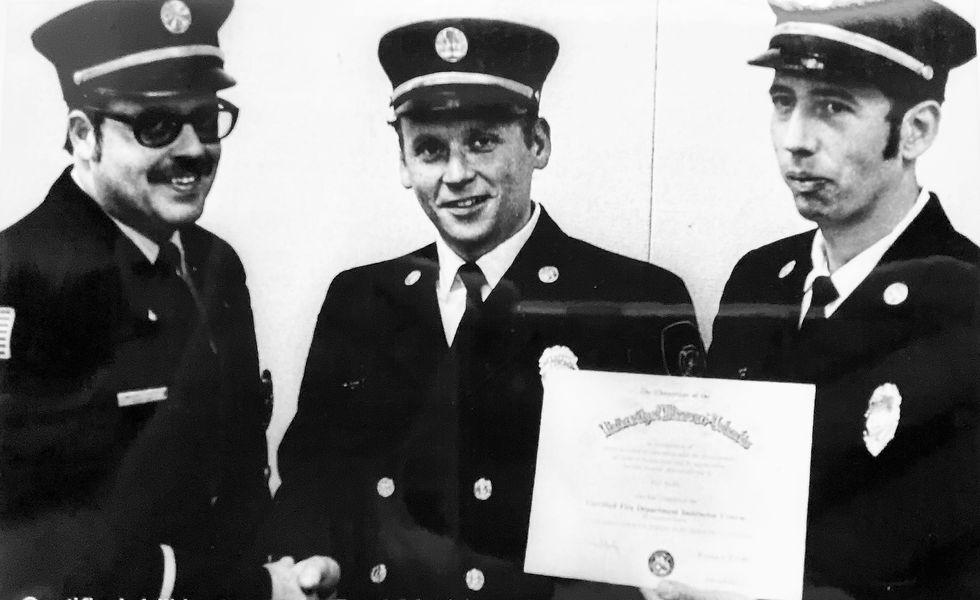Roy Hark, looking back on career of fighting fires, spreading goodwill

Roy Hark’s first fire in the capacity of chief came on June 22, 1989, when the administration building at Hannibal-LaGrange College burned. Courier-Post file photo.
MARY LOU MONTGOMERY
Roy Hark is a familiar fixture in Hannibal, to visitors and residents alike. At the age of 79, he’s a frequent among the lunch crowd at Logue’s Restaurant, and during the dinner hour at Fiddlestiks, where he discusses issues of the day with passersby, about the positives of the town he has called home during all but his military years.
“I can tell a lot of stories; I’m quite full of the blarney,” he said. “I enjoy people. When I sit out at Logues and eat lunch, I say to people, ‘how you doing?’
“You’re Hark?” they respond.
“(Larry) Logue told me one day ‘I need to make you a door greater.’ I like to talk. The world be a little better place if people would be friendly to each other.
“I am genuine. If I come up and start talking to you, it is genuine. I can’t say there are very many people I don’t like. Once I start talking to them, they will know who I am.
“People who see me at Logues, they remember me because I made an impression by talking to them. We need to be friendly with everybody.”
Hannibal born
Born of humble beginnings, Roy Hark rose through the ranks into Hannibal leadership roles twice:
First, as Hannibal’s fire chief; and
second, as a five-term Hannibal mayor.
“I was proud of the fact I was able to lift myself up and move on. My brother John and I both worked for the city for years; we did a fair job for the city.”
Now retired, Roy Hark has time to reflect upon the directions the city has taken during his lifetime, and the people - past and present - who collectively impacted the city’s status.
“I’m proud that I came back here” in 1966, after serving with the military, he said. “Hannibal's a great place to live and raise your kids.”
Post military years
When he returned to Hannibal in 1966 after serving a stint with the military, Hark first applied to the Hannibal police department, which didn’t have any openings at the time. Next, he approached the fire department, and was offered a job.
“I think I’m most proud of being a Hannibal firefighter,” he said.
During the 32 years he worked with the fire department, “I had several chances to leave and go to St. Louis,” he said, to work for various fire departments. “And I wouldn’t do it. (Hannibal) hired me and that’s where I’ll be.”
He worked his way up through the ranks of the department, serving as secretary to Chief Tommy McLaughlin, hoseman, driver, drilling instructor, deputy chief and ultimately, chief.
He was chief for the last nine years of his 32-year fire department career.
The two best chiefs he worked under, Hark said, were Tommy McLaughlin and Delmar McClain.
“Tommy, he’d tell you what he expected; if he told you something that’s the way it was.
“Delmar was good at helping you understand.” Hark and McClain spent a lot of time driving around the city, looking for potential issues of concern. The chief would see something he considered troubling, and say, ‘You know that could be a problem for us.’ I rode miles around the city with him.”
Both of the aforementioned chiefs believed in education, as did Hark himself.
The city once offered firemen the opportunity to continue their education at Forest Park Community College. Three men, Paul Maddox, Frank Desmond and Hark, took the city up on their offer. They commuted to St. Louis once a week for classes. The city paid for their transportation, while the men used their GI benefits to cover the cost of tuition, Hark said.
They earned associate degrees in fire safety/science, and used that training, during the ensuing years, to educate others on the force.
“I helped start the first responder program,” Hark said. Later firefighters trained to become EMTs. “There are a lot of EMTs on our department today, they are doing a fine job; I’m very proud of those men. I’m proud to say I’m a brother to them.”
Hark later earned a degree from Hannibal-LaGrange College.
When Hark started on the fire department, there was one breathing apparatus on each truck. “We went into those fires, and trying to hold our breath. But we ended up with a lot of smoke in our lungs,” he said.
They obtained more air packs as the years went on. “Now there is one for each man,” he said.
“Today, if they have a fatality, they get counseling. When I was there they didn’t do that.
“I’ll never forget when I was in on finding two children who died in a fire.” After returning to the station, he told the chief, “I can’t hack this.” The chief replied, “Roy, you go home and tomorrow morning, remember, there has to be somebody doing this. Maybe you save some; do your very best. That’s all you can do.”
He served as pallbearer for one young fire victim.
“The fire department is a tough job, when you work, you work. There is a lot of tragedy.
“I had some good men work for me. I’m proud of every one of them, they all do a good job. I think I was a good chief; a little hard sometimes, but you have to make sure they don’t get hurt at fires. You have to do your best.”
He particularly remembers Gene Holcomb and Dwayne Stombaugh, who served as deputy chiefs during Hark’s tenure as chief, and Becker Spaun, who was the department secretary. “He kept things straight,” Hark said.
The most momentous time in Hark’s fire career came in June 1989, the fire at Hannibal-LaGrange College.
Norman Sanders was retiring as chief, and was on vacation. Hark had already been chosen to replace the retiring Sanders. When the fire call came in, Hark called Sanders, who gave the nod for Hark to step up and take charge.
“We were out there for 27 hours. I had over 200 men on that fire. We called for mutual aid. I had departments from Center, Perry, Hull, New London, Palmyra, Monroe City and Quincy. They all came down to help me.
“I never forget. I was so frustrated. The news media in St. Louis got in my face, and they said, ‘What do you think, chief?’ I looked at them and said, ‘I don’t have enough water or hose or trucks and I think the whole thing will burn down.’”
And his statement, just as he said it, went on the air in St. Louis.
Hark’s uncle called him afterwards. “Was you a little upset?”
On a lighter side, there was a reporter from Quincy who was carrying a big boom box recorder on her shoulder. She put it down. “They were backing in tractor trailers and unloading our tanks, and they backed up right over her camera. She came to me crying,” he said.
Note:
Mary Lou Montgomery was a cub reporter for the Hannibal Courier-Post in June 1979, covering the fire and police beats. She was on the scene to report on, and take photos of, a fire involving two houses on North Fourth Street, one owned by Marvin and Patsy Rayl. Roy Hark, senior officer at the fire scene, put a helmet on Montgomery when imminent danger was over, and allowed her to take up-close photos at the fire scene. This helped her launch a reporting career which would continue until her retirement as editor of the newspaper in December 2014.

Paul Maddox, left, Frank Desmond and Roy Hark, right, became certified instructors after graduating from the Forest Park Community College in the late 1970s. Courier-Post file photo.

Roy Hark, pictured during the supper hour at Fiddlestik’s in September 2024, can’t pass up an opportunity to visit with friends and potential friends. He served five terms as Hannibal mayor, and was chief of the Hannibal Fire Department for 9 years. Photo by Mary Lou Montgomery

























Comments